Get insights.
Unlock value.
- 14-day free trial
- Set up in minutes
- No credit card required
Van Westendorp Pricing Scale
Introduction
The van Westendorp Pricing Scale is a pricing analysis technique that helps businesses determine the optimal price for their products or services. This method provides valuable insights into customer perceptions of pricing and aids businesses in setting a price range that maximizes revenue while satisfying customer demand. In this blog, we will explore the BlockSurvey's van Westendorp Pricing Scale component and understand how it can be effectively applied in the world of business.
What questions do you ask?
"Time is money", Let us assume you are about to embark on a pricing research and the last thing you want is messing up the questions and wasting your customer's time or infinitesimally worse wasting your own time. Don't worry, coming to your rescue is the van Westendorp Pricing Scale which is built around Four key questions:
- At what price would you consider the product/service to be a bargain, too good to pass up?
- At what price would you consider the product/service to be getting expensive, but you'd still consider buying it?
- At what price would you consider the product/service to be so inexpensive that you'd feel the quality couldn't be very good?
- At what price would you consider the product/service to be so expensive that you would not consider buying it?
Now that we know the questions, all that is left is asking each customer four questions, collecting their responses and analyzing the data collected. Sounds good but seems tedious. But what if we tell you there is a dedicated van Westendorp component in BlockSurvey which can cover all Four questions in a single go and answering them would be an exciting experience for your customer as well. That's right, we make it all happen in a single question.
How to set up your van Westendorp component in BlockSurvey?
Its simple and straightforward,
Add van Westendorp question type from the Pricing Research group of components.
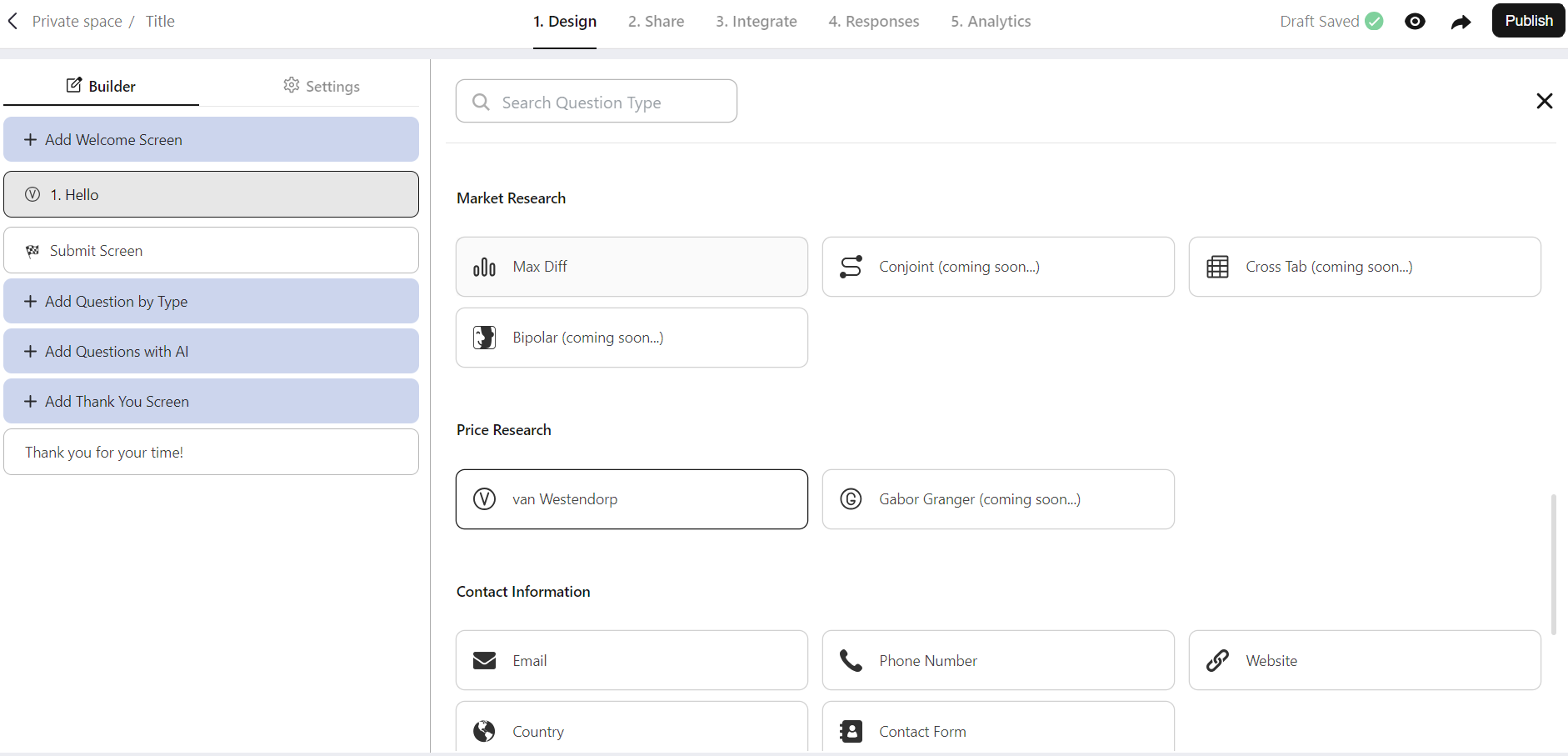
Add appropriate question label and description based on your product/service.
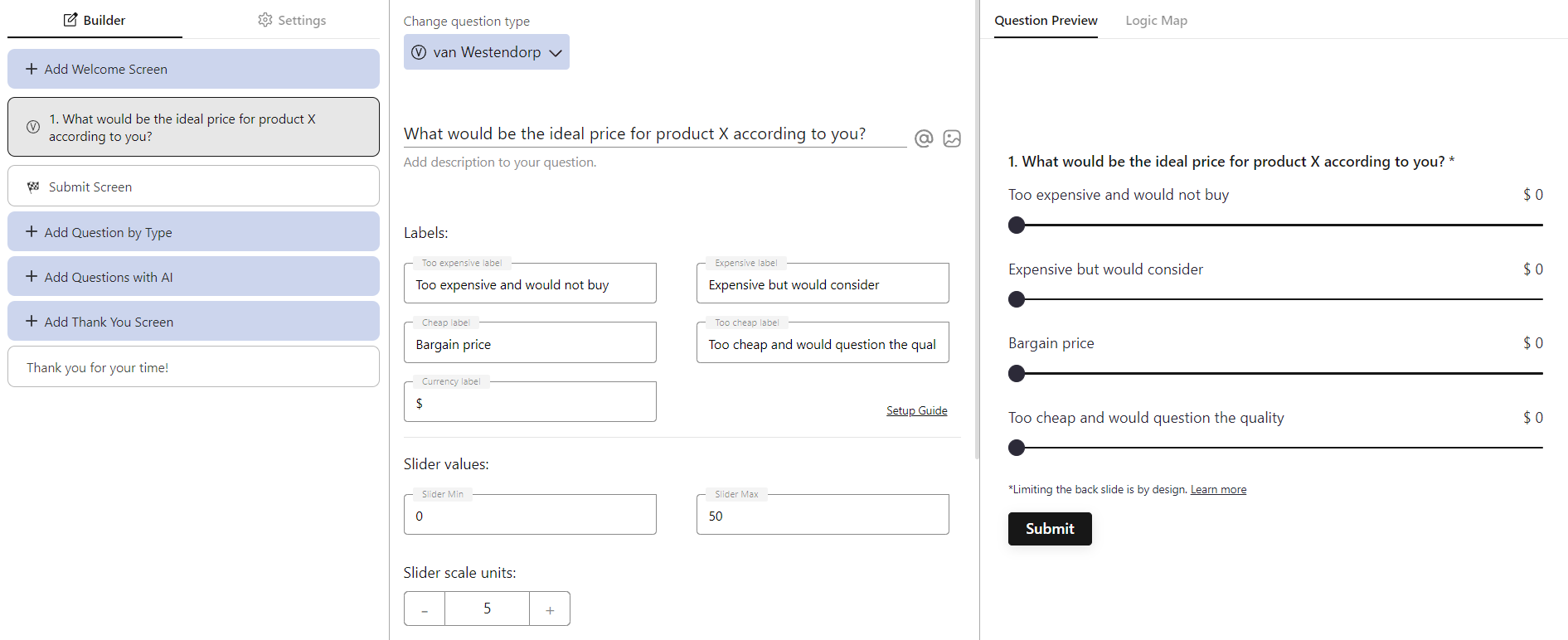
Next would be setting the van Westendorp Labels. These Labels represent the four questions of the van Westendorp Pricing Scale. By default these are set to:
- Too expensive and would not buy
- Expensive but would consider
- Bargain price
- Too cheap and would question the quality.
You may alter them or leave them as such.
Next you may use the Slider values section to change your pricing ranges i.e. set minimum and maximum values for slider and also adjust the slider step value. Default values are minimum - 0, maximum - 50, slider step - 5.
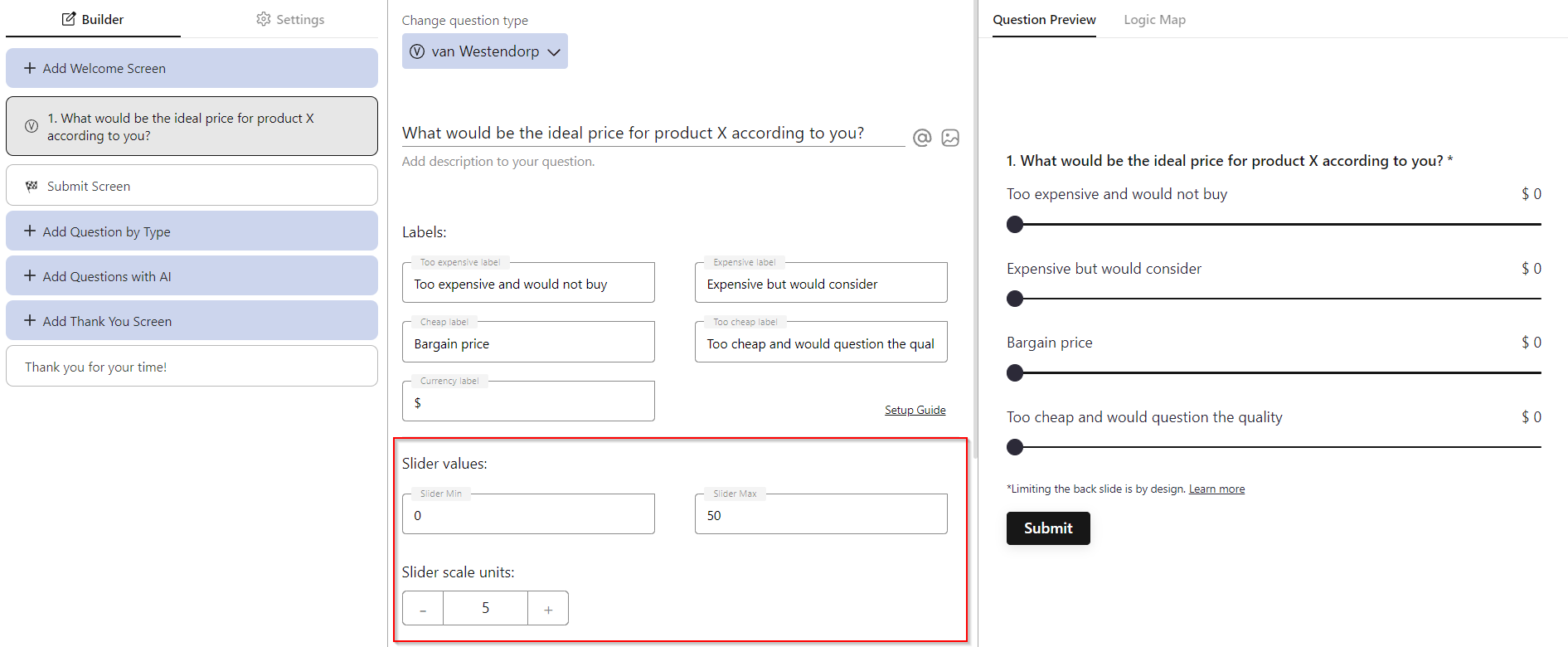
Your van Westendorp component is all ready and set to roll.
How is the survey taken?
Now, the van Westendorp component in BlockSurvey is a set of Four sliders representing the Four questions of van Westendorp Pricing Scale. Respondents have to set all four sliders to the price levels which seem most appropriate to them. To preserve data integrity, the values are limited when sliding backward. Without limiting the backwards sliding, users could enter $10 for too expensive and $20 for too cheap, leading to invalid data.
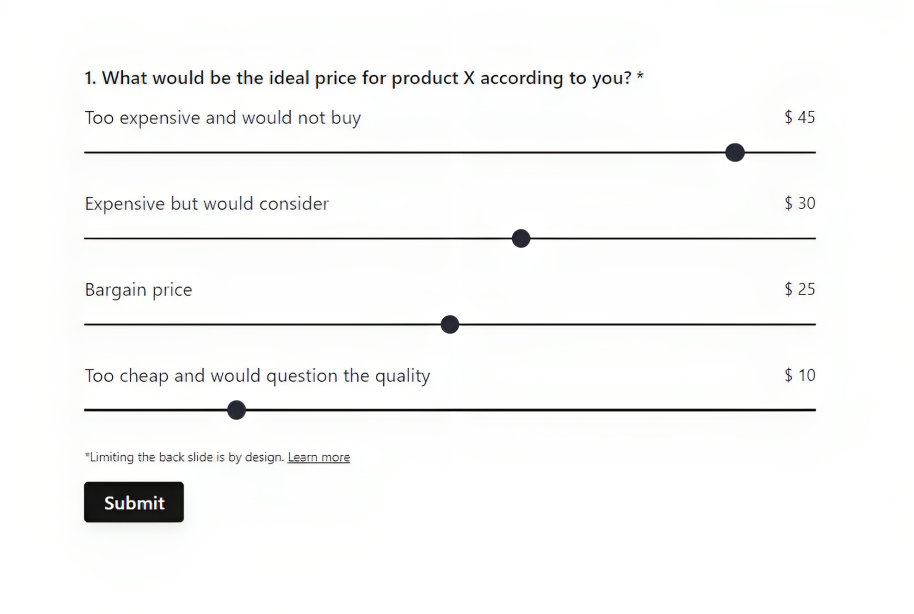
Other platforms use a simple input box. Those users need to click "submit", and then the system tells them to enter a new price. This produces confusion for respondents and is time consuming. Keep in mind my friend, "Time is Money"!!
How do you interpret the results
Once the survey data is collected, the responses are plotted on a graph, i.e. the frequency of responses for each price point. This graph will help identify the following:
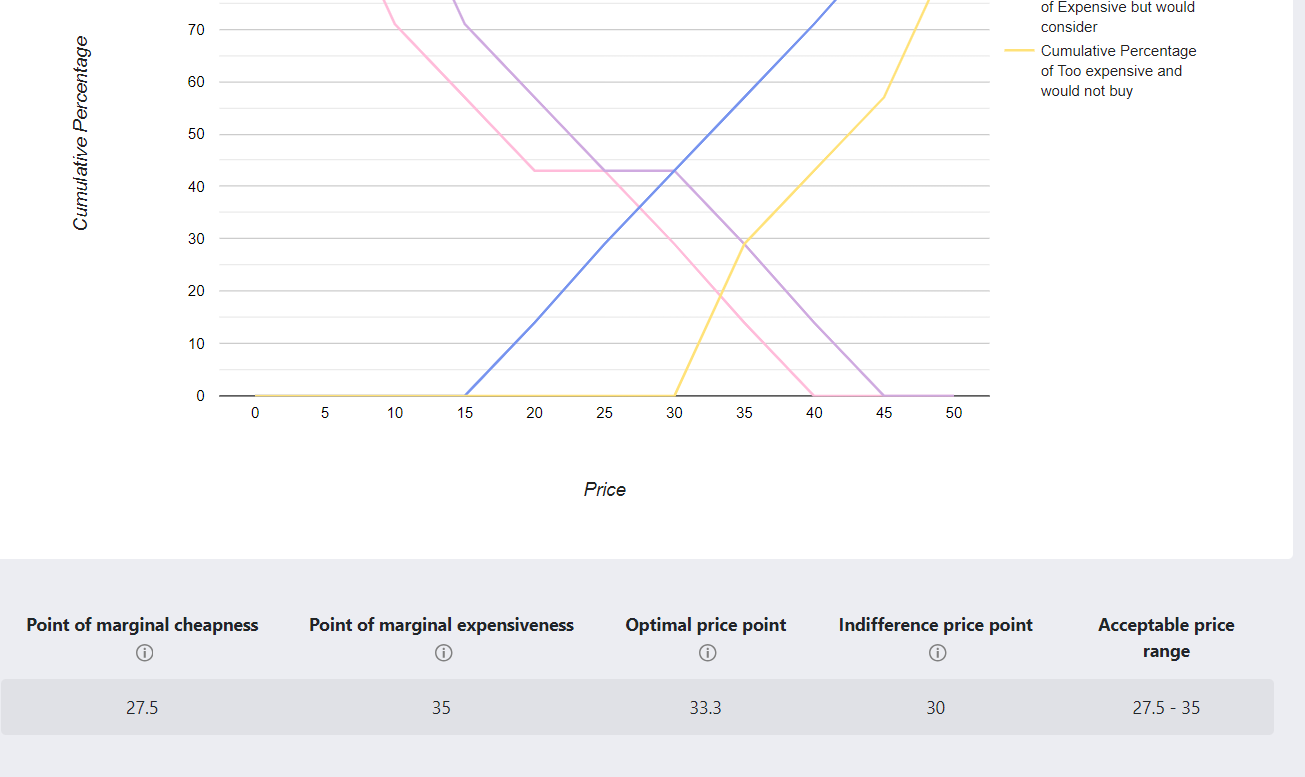
- Point of Marginal Cheapness (PMC): The price below which customers might question the quality or value of the product due to its low price.
- Point of Marginal Expensiveness (PME): The price beyond which customers perceive the product to be too expensive and are reluctant to purchase.
- Optimal Price Point (OPP): The price that represents the peak of the demand curve, where the most significant number of customers are willing to buy the product.
- Price Indifference Point (PIP): The price at which the same number of respondents find the product cheap as those who find it expensive.
Based on the analysis, determine a pricing range that accommodates the OPP. This range will provide flexibility in pricing strategies and allow for optimal revenue generation.
Advantages of the van Westendorp Pricing Scale
- Data-Driven Decisions: The van Westendorp method relies on quantitative data, providing a structured approach to pricing decisions.
- Insights into Customer Perception: Understanding how customers perceive pricing allows businesses to align their pricing strategies with customer expectations.
- Optimal Pricing Strategy: By identifying the optimal price range, businesses can maximize profits while maintaining customer satisfaction.
Conclusion
BlcokSurveys's van Westendorp Pricing Scale component is a valuable tool in the toolkit of pricing analysts. Its ability to provide clear insights into customer perceptions and assist in setting optimal price ranges is invaluable for businesses aiming to thrive in competitive markets. By effectively utilizing this technique, companies can make informed pricing decisions that balance profitability and customer satisfaction, ultimately contributing to their success in the market.
Van Westendorp Pricing Scale FAQ
What is the Van Westendorp Pricing Scale?
The Van Westendorp Pricing Scale is a market research technique used to determine optimal pricing for a product or service.
How does the Van Westendorp Pricing Scale work?
The scale involves asking consumers four questions related to price perceptions, including the point at which the price is too low, too expensive, a bargain, and too expensive to consider.
Why is the Van Westendorp Pricing Scale important for businesses?
The scale helps businesses identify the price range that maximizes demand and profitability, assisting in setting competitive pricing strategies.
Can the Van Westendorp Pricing Scale be used for any industry?
Yes, the scale is applicable to a wide range of industries, including both products and services.
Can the Van Westendorp Pricing Scale be used for new product launches?
Yes, the scale is particularly useful for determining pricing strategies for new products, helping businesses avoid underpricing or overpricing.
Is it necessary to have statistical knowledge to use the Van Westendorp Pricing Scale?
While statistical knowledge can be beneficial, the scale is designed to be accessible to a wide range of users, making it user-friendly for businesses without extensive statistical expertise.
Get insights.
Unlock value.
- 14-day free trial
- Set up in minutes
- No credit card required
